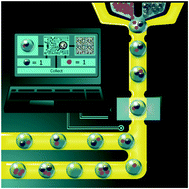Our official English website, www.x-mol.net, welcomes your
feedback! (Note: you will need to create a separate account there.)
Deep learning guided image-based droplet sorting for on-demand selection and analysis of single cells and 3D cell cultures.
Lab on a Chip ( IF 6.1 ) Pub Date : 2020-03-03 , DOI: 10.1039/d0lc00055h Vasileios Anagnostidis 1 , Benjamin Sherlock 1 , Jeremy Metz 1 , Philip Mair 2 , Florian Hollfelder 2 , Fabrice Gielen 1
Lab on a Chip ( IF 6.1 ) Pub Date : 2020-03-03 , DOI: 10.1039/d0lc00055h Vasileios Anagnostidis 1 , Benjamin Sherlock 1 , Jeremy Metz 1 , Philip Mair 2 , Florian Hollfelder 2 , Fabrice Gielen 1
Affiliation

|
Uncovering the heterogeneity of cellular populations and multicellular constructs is a long-standing goal in fields ranging from antimicrobial resistance to cancer research. Emerging technology platforms such as droplet microfluidics hold the promise to decipher such heterogeneities at ultra-high-throughput. However, there is a lack of methods able to rapidly identify and isolate single cells or 3D cell cultures. Here we demonstrate that deep neural networks can accurately classify single droplet images in real-time based on the presence and number of micro-objects including single mammalian cells and multicellular spheroids. This approach also enables the identification of specific objects within mixtures of objects of different types and sizes. The training sets for the neural networks consisted of a few hundred images manually picked and augmented to up to thousands of images per training class. Training required less than 10 minutes using a single GPU, and yielded accuracies of over 90% for single mammalian cell identification. Crucially, the same model could be used to classify different types of objects such as polystyrene spheres, polyacrylamide beads and MCF-7 cells. We applied the developed method for the selection of 3D cell cultures generated with Hek293FT cells encapsulated in agarose gel beads, highlighting the potential of the technology for the selection of objects with a high diversity of visual appearances. The real-time sorting of single droplets was in-line with droplet generation and occurred at rates up to 40 per second independently of image size up to 480 × 480 pixels. The presented microfluidic device also enabled storage of sorted droplets to allow for downstream analyses.
中文翻译:

深度学习指导基于图像的液滴分选,可按需选择和分析单细胞和3D细胞培养。
揭示细胞种群和多细胞构建体的异质性是从抗菌素耐药性到癌症研究领域的一个长期目标。液滴微流控技术等新兴技术平台有望以超高通量解密此类异质性。但是,缺少能够快速识别和分离单细胞或3D细胞培养物的方法。在这里,我们证明了深度神经网络可以根据微对象的存在和数量(包括单个哺乳动物细胞和多细胞球体)实时准确地对单个液滴图像进行分类。这种方法还可以识别不同类型和大小的对象混合物中的特定对象。神经网络的训练集包括手动选取的几百个图像,每个训练课程最多可增加数千个图像。使用单个GPU进行培训所需的时间少于10分钟,并且单个哺乳动物细胞识别的准确性超过90%。重要的是,可以使用相同的模型对不同类型的对象进行分类,例如聚苯乙烯球,聚丙烯酰胺珠和MCF-7细胞。我们将开发的方法用于选择由封装在琼脂糖凝胶珠中的Hek293FT细胞生成的3D细胞培养物,突显了该技术在选择具有高度视觉外观的对象方面的潜力。单个液滴的实时分选与液滴的产生是一致的,并且独立于最大480×480像素的图像大小,以每秒40的速率发生。提出的微流体装置还使得能够存储分类的液滴,以允许下游分析。
更新日期:2020-03-03
中文翻译:

深度学习指导基于图像的液滴分选,可按需选择和分析单细胞和3D细胞培养。
揭示细胞种群和多细胞构建体的异质性是从抗菌素耐药性到癌症研究领域的一个长期目标。液滴微流控技术等新兴技术平台有望以超高通量解密此类异质性。但是,缺少能够快速识别和分离单细胞或3D细胞培养物的方法。在这里,我们证明了深度神经网络可以根据微对象的存在和数量(包括单个哺乳动物细胞和多细胞球体)实时准确地对单个液滴图像进行分类。这种方法还可以识别不同类型和大小的对象混合物中的特定对象。神经网络的训练集包括手动选取的几百个图像,每个训练课程最多可增加数千个图像。使用单个GPU进行培训所需的时间少于10分钟,并且单个哺乳动物细胞识别的准确性超过90%。重要的是,可以使用相同的模型对不同类型的对象进行分类,例如聚苯乙烯球,聚丙烯酰胺珠和MCF-7细胞。我们将开发的方法用于选择由封装在琼脂糖凝胶珠中的Hek293FT细胞生成的3D细胞培养物,突显了该技术在选择具有高度视觉外观的对象方面的潜力。单个液滴的实时分选与液滴的产生是一致的,并且独立于最大480×480像素的图像大小,以每秒40的速率发生。提出的微流体装置还使得能够存储分类的液滴,以允许下游分析。











































 京公网安备 11010802027423号
京公网安备 11010802027423号